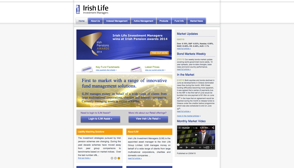Approved Retirement Fund (ARF)
An option that may be available to you at retirement is to invest your pension fund in an Approved Retirement Fund (ARF). ARFs are special investment funds which can give you increased flexibility in terms of how you use your pension fund after retirement.
With an ARF you manage and control your pension fund. You can be happy in the knowledge that you can withdraw as much of this as you wish, should you ever need to. Any withdrawals you take from your ARF will be subject to income tax*, the Universal Social Charge and PRSI (if you are liable for this). In the meantime the fund will continue to be invested in funds of your choice.
Money can be transferred from one ARF to another if you have more than one.
An ARF is available if:
You were a member of a Defined Contribution plan – (and you retired after 07/02/2011) or you were a member of a Defined Contribution plan whose benefit was transferred to a Personal Retirement Bond after 07/02/2011 and/or
you made Additional Voluntary Contributions
and/or you had a Personal Retirement Savings Account (PRSA) or a personal pension plan
and
your lump sum at retirement did not exceed 25% of your fund value and was not calculated based on your service and salary. **
*These amounts may change (up or down) in the future. The amounts quoted are correct as at June 2022.
**if you took a lump sum based on service and salary, you may be able to invest your Additional Voluntary contributions in an Approved Retirement Fund if you satisfy the other qualifying conditions
***If your only source of pre retirement funding is as a member of a Defined Benefit plan and you have not made any Additional Voluntary Contributions, you will not be eligible to invest in an Approved Retirement Fund
Please note the following Revenue regulations:
- From the year you turn 61, tax is payable on a minimum withdrawal on the 30th November each year of 4% of the value of the fund at that date. This withdrawal is liable to income tax, Universal Social charge and PRSI, if applicable. From the year you turn 71 the minimum withdrawal is increased to 5%.
- Where the fund value is greater than €2 million the minimum withdrawal will be 6%. If you have more than one Approved Retirement Fund (ARF) and these are with different managers then you must appoint a nominee Qualified Fund Manager (QFM) who will be responsible for ensuring a withdrawal of 6% is taken from the total value of your ARF’s. It is your responsibility to let your ARF providers know if you have other Approved Retirement Funds and Vested Personal Retirement Savings Accounts with a total value of greater than €2 million.
- Where a greater withdrawal is made during the year, tax will be paid on the greater withdrawal amount. The minimum withdrawal rate is set in line with the required imputed distribution amount which may be altered to reflect changes in legislation. You can choose to take a higher withdrawal amount if you wish.
- The 6% is inclusive of any income you actually take. This applies when the ARF owner is 60 years or over for the whole of the tax tax year and where an ARF is set up after the 6 July 2000.
These amounts and the valuation dates may change as specified by the Government. The information is correct as at June 2022.
Please note for Irish Life ARFs
Due to the imputed distribution requirements introduced by the Finance Act 2006, we will deduct a minimum withdrawal of 5% of the value of the ARF during December each year. This is automatically deducted from your ARF and paid to you net of income tax, PRSI (if applicable), Universal Social Charge (USC) and any other charges or levies (tax) due at the time on the withdrawals you make. This applies from the year you turn 61. Where the total value of your ARFs and vested PRSAs exceed €2 million then a withdrawal of 6% from your ARF must be made each year. It is your responsibility to let us know if you have other ARFs and vested PRSAs with a total value greater than €2 million. For more information please see your product booklet or speak to your financial adviser.
To find out whether you have the option at retirement to invest in an ARF please talk to your financial adviser.
Important points to consider before buying an ARF
If you can choose between buying a pension for life (called an annuity ) and an ARF, it is important to weigh up the pros and cons of both, and consider your own personal circumstances, now and in the future, before you make a final decision.
Advantages of an ARF
Your fund can continue to grow in retirement
By investing in an ARF, your money can remain invested in funds that offer growth potential. The level of this growth obviously will depend on what fund you wish to invest in, its performance and what level of withdrawals you make. This can amount to significant growth over time.
Warning: The value of your investment may go down as well as up.
Your fund passes to your estate on your death.
One of the main differences between an ARF and an annuity is that with an ARF you own your retirement fund. This means that when you die you can leave any remaining funds to your spouse/civil partner or other beneficiaries. If you leave the funds to your spouse or civil partner, the funds can be transferred to an Approved Retirement Fund in their name.
In all other cases, the funds are wound up and the proceeds are passed to your estate. If your estate has to pay income tax, we must take this before paying the proceeds of your fund to your estate.
Your tax adviser will be able to advise you on the Capital Acquisition Tax (Inheritance Tax) implications which may apply also.
A summary of the tax rules after your death (based on rates at July 2015).
| ARF inherited by | Income Tax due | Capital Aquisition Tax due |
| Surviving spouse | No tax due on the transfer to an ARF in the spouse's name | No |
| Children (under 21) | No tax due | Yes* |
| Children 21 and over | Yes (30%) | No |
| Others (including surviving spouse/civil partner if benefit paid out as a lump sum) | Yes, at deceased's tax rate at the time of death (either 20% or 41%) | Yes* |
*Normal Capital Acquisitions Tax thresholds apply.
You are in control of the fund and can take as much or as little from the fund as your financial situation requires
Many people who choose to invest in an ARF have already secured a satisfactory income in retirement (quite often an annuity). They appreciate that, with an ARF, their money is available to them should they need it but remains invested if they don’t. You should note that if your withdrawal is less than 5% (or 6% if your fund value is greater than €2 million) there is a Revenue requirement to treat your fund as if a withdrawal up to those amounts was made - see note above under heading - Please note the following Revenue regulations. You can also choose to convert your ARF fund into an annuity at any stage. By waiting to buy an annuity you might be able to get a higher annuity rate later on for the same lump sum, as you will be older, but there is no guarantee for this.
You can manage your total retirement income to maximise the amount that is taxable at the lower rate
If you wish to withdraw money regularly from your ARF to boost your retirement income, you have the flexibility to do so. People at typical pension levels who withdraw regularly have the option of taking just enough to keep them on the lower rate of tax. This is very attractive if you received tax relief on your contributions at the higher rate but only pay tax on the benefits at the lower rate. Any withdrawals you take from your ARF will be subject to income tax**, the Universal Social Charge and PRSI (if you are liable for this).
**Tax on any withdrawals is deducted as per the tax certificate submitted to your ARF provider or in other cases at the marginal tax rate. The ARF holder is then obliged to claim back any over deducted tax by applying to their own local Inspector of Taxes.
Warning: The income you get from this investment may go down as well as up.
What are the disadvantages of an ARF?
Risk to future income
You need to consider carefully if you are going to use your ARF to pay you an income. Depending on the size of your fund there will be an imputed drawdown from your fund every year. If the ARF grows at a lower rate than the level of imputed drawdown or income you take, then the value of the ARF may run out and leave you with no income.
Investing in funds and investment risk
Depending on which fund you invest in, its value can fall as well as rise over the period of your investment. We recommend that you consider an ARF as an investment for at least five years or more. In general, the longer you leave your investment, the better it is likely to perform. By choosing a low-risk fund, you are protecting any gains you make over the period of investment. However, the potential for large gains is lower than if you choose a high-risk fund.
High-risk funds mainly invest in company shares so their value is not protected but you do have the potential to gain significantly, especially over the long term. If you invest in these funds you should realise that, in wanting a higher return, you could lose some or all of the value of your investment. If you decide to take a regular income from your ARF and the investment growth is lower than the level of income you have chosen, this will reduce your original investment
Consider the risks associated with investing. Everyone's situation is different, and everyone handles risk differently. With the help of your pension contact, you are the best person to decide how much risk you are comfortable with.
Associated costs
You will have to pay for any ongoing investment advice about your ARF.
ARFs can have high ongoing charges which will reduce the value of your fund.
More Information
For more information please contact your financial adviser or Irish Life on (01) 704 1845.
Warning: The value of your investment may go down as well as up.
Warning: This product may be affected by changes in currency exchange rates.
Warning: The income you get from this investment may go down as well as up.
Warning: If you invest in this product you may lose some or all of the money you invest.
The assets in these funds may be used for the purposes of securities lending in order to earn an additional return for the fund. While securities lending increases the level of risk within the fund it also provides an opportunity to increase the investment return.








